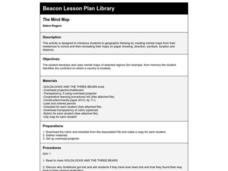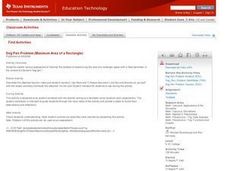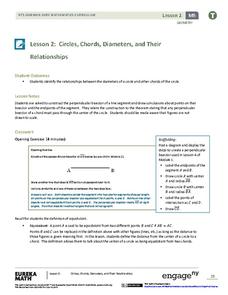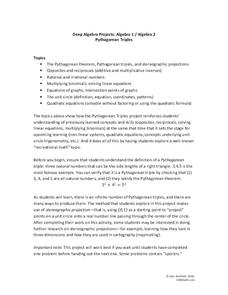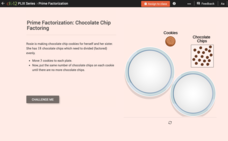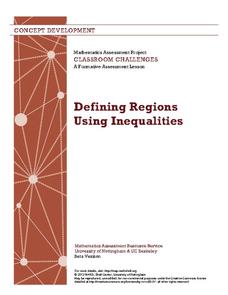Curated OER
The Mind Map
Learners form a mental map of their residence in relation to school and recreate it on paper showing distance, direction, location and symbols. This lesson is designed to introduce students to geographic thinking.
Curated OER
Fraction Food Frenzy
Students study addition of fractions with like denominators using illustrations and problem solving.
Curated OER
Transformations
Several practice exercises suitable for any geometry class working on transformation, symmetry, and tessellation -- especially visual representations of image translation, rotation, and reflection, symmetry, tessellations and tangrams --...
Curated OER
Shorten the Length
Learn how to summarize by identifying main ideas and supporting details. Readers cross out unimportant information as they read through a text. Is it a random detail? Cross it out! They then draw a concept map, placing the main idea in...
Curated OER
Dog Pen Problem
Teach your class about various approaches to solving the problem of maximizing the area of a rectangle space with a fixed perimeter in the context of a farmer's dog pen. Then, they complete a worksheet independently to summarize the...
EngageNY
Circles, Chords, Diameters, and Their Relationships
A diameter is the longest chord possible, but that's not the only relationship between chords and diameters! Young geometry pupils construct perpendicular bisectors of chords to develop a conjecture about the relationships between chords...
Education Development Center
Integer Combinations—Postage Stamps Problem (MS Version)
Number patterns can seem mysterious. Help your learners unravel these mysteries as they complete an intriguing task. Through examination, collaborative groups determine that they are able to produce all integers above a certain value by...
CK-12 Foundation
Large Decimal Rounding to Decimal Representations: Weighing a Whale
An interactive challenges mathematicians to round large numbers with help from a large scale that measures the weight of a blue whale. The practie's five questions include multiple-choice, fill-in-the-blank, true or false, and an open...
CK-12 Foundation
Add and Subtract Decimals with Front-End Estimation: Wooden Beams
A six-question interactive tasks mathematicians to solve addition and subtraction problems using front-end estimation. Question types consist of multiple-choice and true or false. A set of wooden beams that can be measured using moveable...
5280 Math
Pythagorean Triples
From Pythagorean triples to the unit circle. Learners use the Pythagorean Theorem to find Pythagorean triples and then relate their work to the unit circle in a fun algebra project. Their discovery that x^2+y^2 is always equal to one on...
CK-12 Foundation
Decimal Rounding Given Place Value
Tests mathematicians' knowledge of decimals, place value, and rounding with a five-question interactive. A tool with movable parts assists scholars in answering questions—multiple-choice and true or false. A discussion question...
PBS
Working with Coordinate Planes: Activities and Supplemental Materials
Seven activities make up a collection of supplemental materials to reinforce graphing on a coordinate plane. Worksheet objectives include plotting coordinates within single and four quadrants, measuring straight and diagonal lines, and...
Curated OER
Describing Data
Your learners will practice many ways of describing data using coordinate algebra in this unit written to address many Common Core State Standards. Simple examples of different ways to organize data are shared and then practice problems...
Virginia Department of Education
Using Order of Operations and Exploring Properties
If you need some creative ways to teach the order of operations, use a series of activities that focus on properties. Each activity uses different materials and works as a stand-alone activity, or can build upon the concepts of the last...
EngageNY
Relationships Between Two Numerical Variables
Is there another way to view whether the data is linear or not? Class members work alone and in pairs to create scatter plots in order to determine whether there is a linear pattern or not. The exit ticket provides a quick way to...
CK-12 Foundation
Prime Factorization: Chocolate Chip Factoring
An interactive resource challenges mathematicians to show what they know about prime factorization. Five multiple-choice, true or false, and discussion questions use chocolate chip cookies to set a real-world application of the concept.
Arcademics
Sailboat Subtraction
Play a game of subtraction tug of war with an engaging learning game that challenges scholars to answer equations as quickly as possible.
Illustrative Mathematics
Which Weighs More? Which Weighs Less?
Expand the the comparative language of young mathematicians with a hand-on weight measurement activity. Working independently or in pairs, children compare the weight of large wooden blocks to various other classroom objects, recording...
Arcademics
Canoe Puppies
Smiling puppies row their way to the finish line in a learning game that focuses on addition. Scholars go up against multiple players to answer as many addition problems as possible.
Shodor Education Foundation
Measures
Take a look at data from a statistical lens. An interactive allows pupils to enter data set, labeling the data including the units used. Manipulating the applet, learners select the statistics to calculate that include total, mean,...
K12 Reader
Kinds of Angles
Have you ever wondered how circles and angles relate to each other? Read a passage about right angles, acute angles, and obtuse angles, and answer reading comprehension questions about the information you learn.
MARS, Shell Center, University of Nottingham
Defining Regions Using Inequalities
Your young graphers will collaboratively play their way to a better understanding of the solution set produced by the combining of inequalities. Cooperation and communication are emphasized by the teacher asking questions to guide the...
University of Nottingham
Modeling Conditional Probabilities: 2
Bring the concept of conditional probability alive by allowing your classes to explore different probability scenarios. Many tasks have multiple solutions that encourage students to continue exploring their problems even after a solution...
Mathematics Vision Project
Module 3: Geometric Figures
It's just not enough to know that something is true. Part of a MVP Geometry unit teaches young mathematicians how to write flow proofs and two-column proofs for conjectures involving lines, angles, and triangles.


